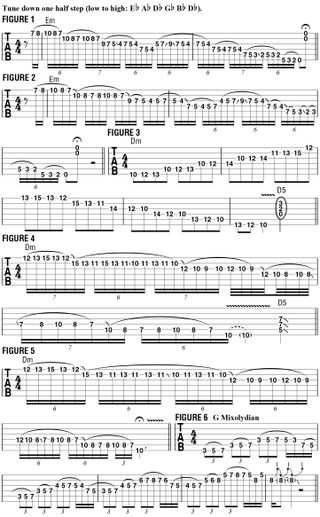How to solo with three-notes-per-string patterns
Nita Strauss shows you a solo approach that will increase your speed and versatility
Last time, I demonstrated the seven modes/positions of the G major scale (G A B C D E F#), played three notes per string. I find that this approach is much more effective and versatile than staying within the standard fixed scale positions that most players learn and later use when soloing.
The three-notes-per-string approach includes a one-fret position shift when crossing from the G string to the B and, as a result, offers a player greater phrasing and note-range options when crafting a single-note line.
If we broaden this approach to include an ascending or descending finger slide of one or two frets, an additional scale position will naturally fall under our fingers. This technique may be performed on any string, so the opportunity for position shifts is further increased, as are your melodic options.
FIGURE 1 presents a fast line performed primarily with hammer-ons, pull-offs and legato finger slides, wherein I pick the strings as little as possible.
After an initial ascending double hammer-on, I move from the high E string over to the B and G strings using multiple pull-offs, and when I get to the G string, I repeat the ascending/descending phrase that initiates the line and continue down to the D string.
On beat four, I move back up to the G string and then descend continually across all of the remaining lower strings, culminating with a pull-off to the open low E.

FIGURE 2 offers a similar and somewhat simplified line played in the same manner. Try to keep your fret-hand fingers directly above and parallel to the frets, striving for clear articulation of each note. Once you have this pattern memorized and feeling comfortable, try inventing a few variations on it by sliding to different positions at other points in the line.
A great way to visualize these lines is to look at them in two-string groups or segments, based on the way the notes fall on consecutive pairs of strings. I begin on the high E and B strings, and then the next series of notes are played on the G and D strings.
I stay on these two strings for a moment by moving back up the G string, and then I continually descend, ending with a line played on the bottom two strings. This kind of visualization and compartmentalization aids in “seeing” phrases in a clear way.
Let’s try applying the three-notes-per-string approach to the D natural minor scale (D E F G A Bb C), shown in 10th/12th position in FIGURE 3. FIGURES 4 and 5 offer examples of fast legato phrases that are based on this scale and utilize the three-notes-per-string approach with finger slides and position shifts.
Our final example, FIGURE 6, is a legato run based mainly on the G Mixolydian mode (G A B C D E F) and involving some rather wide-stretch three-notes-per-strings patterns, beginning in third position. Play through the line slowly at first and ease into the stretches. Greater flexibility will come with consistent practice.
Get The Pick Newsletter
All the latest guitar news, interviews, lessons, reviews, deals and more, direct to your inbox!

Want to play Master of Puppets the right way? Here's how to get faster at downpicking so you can chug like James Hetfield
![Joe Bonamassa [left] wears a deep blue suit and polka-dotted shirt and plays his green refin Strat; the late Irish blues legend Rory Gallagher [right] screams and inflicts some punishment on his heavily worn number one Stratocaster.](https://cdn.mos.cms.futurecdn.net/cw28h7UBcTVfTLs7p7eiLe-840-80.jpg)
“The intensity of Rory’s guitar playing – the emotion, the sound and his incredible attack – was mindblowing for me”: Joe Bonamassa pays tribute to the late, great Irish blues-rock icon Rory Gallagher









